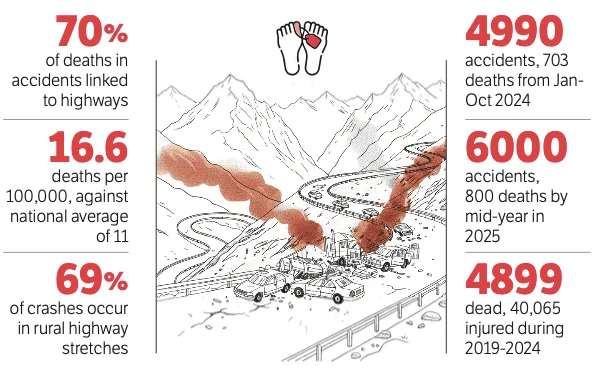Srinagar, Oct 16: In Jammu and Kashmir, roads turn into obituaries.
Behind the postcard views of the region’s highways lies a landscape of loss, of beauty and danger travelling side by side, where mountains claim more lives than they connect.
Every curve on the road hides stories of speed, loss, and neglect.
The design flaws hidden in every bend also carry fear of death among the families, drivers, and rescuers.
The Srinagar-Jammu National Highway (NH-44), the romanticised gateway to paradise, has proven to be a hellish road with its deadly mix of heavy traffic, unreliable road conditions, landslides, and human error.
The 270-km stretch is the major link to Kashmir, and together with other link roads along its course, is a major contributor to the staggering deaths due to road traffic accidents in J&K.
The Road Traffic Accident (RTA) mortality rate in J&K is 16.6 deaths per 1 lakh population.
It starkly exceeds the national average of 11 deaths per 1 lakh.
RTAs are the leading cause of Disability-Adjusted Life Years (DALYs) lost in J&K, outweighing other health burdens.
Between January and October 2024, J&K recorded 4990 accidents that resulted in 703 deaths and 6820 injuries, as per official data.
This trend extends into 2025.
Partial data up to June suggests continued spikes.
Given the trends, it is an estimated 6000 accidents with fatalities nearing 800.
The NH-44 is prone to fatal crashes in districts like Ramban and Udhampur.
However, the data is not separated for the highway and other roads in the districts along the highway.
In the first half of 2024, Udhampur saw 228 accidents, 47 deaths, and 314 injuries, while Ramban reported 129 accidents, 33 deaths, and 160 injuries.
In 2025, so far, the highway has seen devastating accidents.
On May 4, a crash near Battery Cheshma in Ramban claimed the lives of three Army personnel.
Last month, two policemen died in a crash at Tengan, Lasjan.
Earlier, a mother-son duo died in a collision near Tikrri, Udhampur.
This month, a cab overturned in Battal Ballian, Udhampur, leaving one dead and four injured.
Over the three quarters of 2024, districts along the highway route had horrifying stats.
Jammu district had 807 accidents, 96 deaths in the first nine months of 2024.
Anantnag had 254 accidents with 35 deaths; Srinagar recorded 362 accidents and 36 deaths.
Full-year data for Srinagar shows 57 people lost life in accidents in 2024.
Although, J&K is yet to come up with a detailed report on accident-prone spots and the causes of accidents, preliminary data suggests over-speeding is the reason for accidents 40 percent of the time.
Then comes reckless driving, and engineering flaws like single-lane sections prone to head-on collisions.
In J&K, rural areas, particularly the roads along the National Highway comprise 69 percent of accidents.
The Chenab Valley is another “silent death trap.”
The three districts, Doda, Kishtwar, and Ramban accounted for 20 percent of J&K’s road fatalities, despite having a sparse population.
From 2019 to October 2024, Chenab Valley recorded 852 deaths.
Ravine plunges are the primary type of accident along the narrow, treacherous roads.
The National Highways, including NH-244, see the maximum number of casualties.
Yet, these hardly make headlines.
Between 2019 and 2024, 4899 lives were lost on roads in J&K and 40,065 people injured.
Many of those injured ended up with lifelong disabilities.
The J&K Road Safety Policy, 2025, notified in March this year has a lofty aim to reduce accidents and fatalities by 50 percent by the year 2030.
This can be achieved through better enforcement of traffic rules, better equipped and accessible trauma centres, and infrastructure upgrades of roads.
However, policy makers believe that with 22.66 lakh vehicles, and counting, the task is daunting but not impossible.
A regular commuter on the highway, Muhammad Ishfaq, said that with winters approaching, and already dilapidated roads going to get worse, would these highways lead to heaven or hell?
“For many, the answer is tragically clear,” he said.








